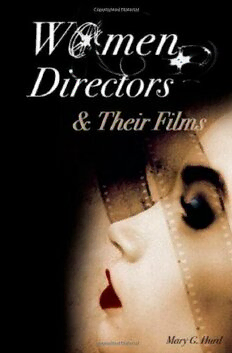
Women Directors and Their Films PDF
Preview Women Directors and Their Films
Women Directors and Their Films [] Women Directors and Their Films [] Mary G. Hurd LibraryofCongressCataloging-in-PublicationData Hurd,MaryG. Womendirectorsandtheirfilms/MaryG.Hurd. p. cm. Includesbibliographicalreferencesandindex. ISBN0–275–98578–4(alk.paper) 1.Womenmotionpictureproducersanddirectors–Biography. I.Title. PN1998.2.H86 2007 791.43023(cid:1)30922–dc22 2006029526 [B] BritishLibraryCataloguinginPublicationDataisavailable. Copyright©2007byMaryG.Hurd Allrightsreserved.Noportionofthisbookmaybe reproduced,byanyprocessortechnique,withoutthe expresswrittenconsentofthepublisher. LibraryofCongressCatalogCardNumber:2006029526 ISBN:0–275–98578–4 Firstpublishedin2007 PraegerPublishers,88PostRoadWest,Westport,CT06881 AnimprintofGreenwoodPublishingGroup,Inc. www.praeger.com PrintedintheUnitedStatesofAmerica Thepaperusedinthisbookcomplieswiththe PermanentPaperStandardissuedbytheNational InformationStandardsOrganization(Z39.48–1984). 10 9 8 7 6 5 4 3 2 1 Contents Introduction vii CHAPTER1: PIONEERS 1 DorothyArzner 2 IdaLupino 7 CHAPTER2: THEMAINSTREAM 14 NoraEphron 15 NancyMeyers 20 AmyHeckerling 22 MarthaCoolidge 28 KathrynBigelow 40 MimiLeder 47 CHAPTER3: INDEPENDENTS,EXPERIMENTS, DOCUMENTARIES 52 MayaDeren 53 LizzieBorden 59 MaryHarron 63 JulieDash 66 NancySavoca 71 AllisonAnders 74 PenelopeSpheeris 78 BarbaraKopple 83 CHAPTER4: INTERNATIONAL 93 GillianArmstrong 93 JaneCampion 101 LeniRiefenstahl 112 vi Contents AgnesVarda 119 LinaWertmuller 126 CHAPTER5: NEWCOMERS 130 SofiaCoppola 130 KimberlyPeirce 133 PattyJenkins 135 KasiLemmons 136 CHAPTER6: ACTRESSESTURNEDDIRECTORS 139 AnjelicaHuston 139 PennyMarshall 141 BarbraStreisand 146 ElaineMay 148 Conclusion 153 Filmography 155 Bibliography 161 Index 167 Introduction The reader of this book will be introduced to basic biographical and critical informationaboutselectedwomendirectors.Althoughitisprimarilyofferedto thosewhowanttoknowmoreaboutwomendirectors,filmstudentsorenthusiasts mayalsofindsomethingofinteresthere.Thewomenincludedinthisdiscussion werechosenonthebasisoftheircontributionstofilmmakingintheUnitedStates orbecausetheirfilmsarewidelyknownintheUnitedStates.Owingtolimited space, the women presented in each category, with the exception of Arzner andLupino,aremerelyrepresentativeandnotexhaustive.Manyothersdeserve recognitionandappreciationandshouldbethesubjectsoffuturevolumes. The book progresses in a somewhat chronological fashion, beginning with Dorothy Arzner and Ida Lupino, the only two mainstream women directors in Americauntil1971, whenElaineMaybecamethefirstwomantowrite,direct, andperforminherownfilm.ThemainstreamsuccessofNoraEphroninthe1980s andNancyMeyersin2001and2003hingedontheirfacilitywiththeromantic comedy genre. Both Amy Heckerling and Martha Coolidge found mainstream successwithhigh-schoolteencomedy,whereasMimiLederandKathrynBigelow weresingularlynotedfortheiractionandspecialeffects. The burden on mainstream directors to make money for the studios—more rigorous for women and usually dependent upon formula films—has led most women to consider independent films as a means of expressing their personal visions of women’s lives and experiences. Lizzie Borden, who promotes radical feministviews,sawdocumentariesasaprimarymeansofdisseminatingherbeliefs regardingtheresponsibilityofwomentochoosetheirownimages,whereasMary Harron’slifelonginterestinpopularcultureledtoherintensestudiesofderanged characters.Otherfilmmakersrepresentingspecificethnicorsocialbackgrounds— Dash, Savoca, Anders, Spheeris—have been very vocal about their desires to communicatemeaningfulexperiencesforotherwomenwithsimilarbackgrounds. viii Introduction ThegoalofBarbaraKoppleinherdocumentariesofstrugglingworkershasalways beentoprovideavoiceforthosewhohadnone. Theinternationaldirectorsincludedinthisvolume,whilereflectinginterest- inghistoricaltrendsandsocialconditionsintheirrespectivecountries,arealso noteworthyinthat,withtheexceptionofRiefenstahl,allarecontinuingtomake films. Each of the four talented, young newcomers, has made a large impact on thecinemaworldwithherinterpretationsofwomen’sexperiences,andperhaps provides indications for the future of women’s films. Of the four directors who gainedaccesstodirectingbyvirtueoftheiractingexperience,MayandMarshall havenotmadefilmsexclusivelyaboutwomen. I must express my gratitude to students who have responded to the study of womendirectorsandwhohavesharedmyfrustrationwiththelimitedopportu- nities for women directors. I appreciate the tireless efforts of research assistants Wilson Onstott, Paul Ludwig, and especially Reg Ivory. Also, I am indebted to myfamilyfortheirpatienceandencouragement. [ ] 1 Pioneers In the early years of film, opportunities for women were plentiful, ranging from positionsastypists,assistants,writers,editors,actresses,withsomewomengaining chances to direct, and a few creating their own companies. Pioneering woman director,AliceGuyBlache,secretaryofLeonGaumontofGaumontStudiosin France, directed in 1896, La Fee aux Choux (The Cabbage Fairy), arguably the firstfictionalfilm.Between1896and1907,shedirectedaround400films(Silent, Slide viii). She and her husband came to the United States and she set up her own studio in New Jersey, where she turned out an additional 354 films (Slide viii).America’s“firstnativewomanfilmdirector”(Slideviii),LoisWeber,who also began writing and directing at the American branch of Gaumont Studios, was one of the most important and highly paid American filmmakers in the 1910s (Corrigan and White 384). A true auteur, Weber wrote the films she di- rectedand,earlyon,starredinthem,usingthemasamediumforherideasand philosophy (Slide viii). Screenwriter Frances Marion started with Weber and wentontowritescreenplaysformorethan150filmsinhercareer(Corriganand White384).Mrs.WallaceReid,aformeractress,returnedtodirectingandpro- ducingafterherhusband’sdeathandmadenumerousmelodramas.Slidehasnoted thatbetween1911and1920,womenweredirectingfilms“asoftenandaswellas theirmalecounterparts”(iv),althoughtheexactnumberofthesewomen,many ofwhomwereuncreditedorwhosefilmshavebeenlost,mayneverbeknown. Bythe1920s,mostwomen,otherthaneditorsandscreenwriters,encountered difficultiesasthemoviesbecamebigbusiness.Owingtotheproductioncostsin the 1930s, the growing departmentalization of filmmaking, and the reluctance ofstudioexecutivestotrustadirectorofsilentfilmswithtalkies,thenumberof womendeclinedsharplyafterthecomingofsoundinthelate1920s.Manynotable womenandmalesilentfilmdirectorswereshuttledasideforstagedirectors,mostly male,andfromNewYork.Inthe1930s,unionsandguildswerefirmlyestablished inHollywood,withpredominantlymalemembership,andfewwomenoccupied
